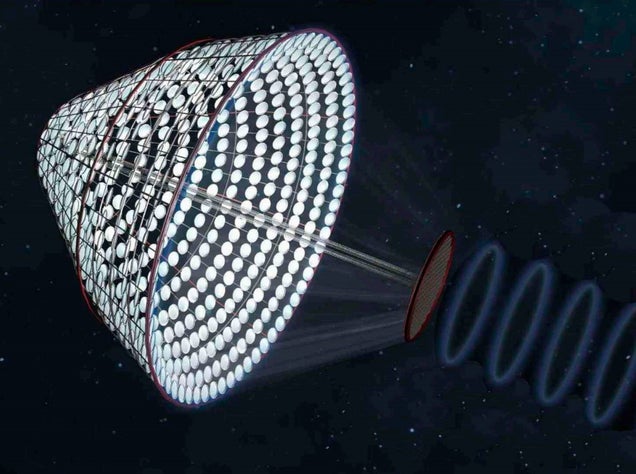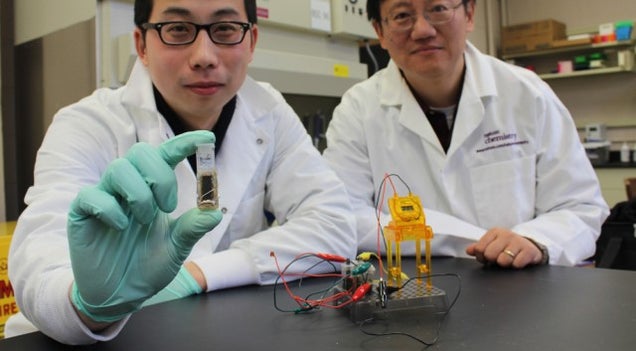If humans are going to keep living in the style to which we're accustomed, we need to find alternatives for fossil fuels. Partly that's because we need to reduce pollution — and partly because those fossil fuels are going to run out. But alternative forms of energy may look a lot weirder than you think.
 |
| Image source: io9.com |
1. Tobacco Leaves
Most people have heard about turning corn into biofuel. But corn is actually a terrible biofuel source for a number of reasons, which is why many scientists are looking to other plants for future fuel — including tobacco. Genetically modified tobacco, that is. The main building blocks for biofuel in plants are starch and sugar, so naturally, increasing the amount of starches and sugars in a plant will improve fuel production. An agricultural engineer recently found that she could tweak a gene in tobacco to boost starch production by 700%, which translated to an increased sugar yield (a step in biofuel production) of 500%. As a bonus, this technique could be used on food crops to increase starch and sugar production.
2. Sugar Batteries
Current battery technology relies on toxic metals, which are difficult to mine, have limited lifespans, and create recycling and disposal issues. Sugar, on the other hand, has none of those problems. Recently, a group of bioengineers built a prototype of an "enzymatic fuel cell" that imitates the behavior of biological systems (like plants) that convert glucose to energy. The resulting battery creates more energy than a lithium-ion battery, is biodegradable, and refillable.
 |
| Image source: io9.com |
3. Jatropha curcas
This plant produces oil-rich seeds which are excellent for biodiesel, and it is able to thrive in dry, sandy lands that aren't good for food production. That means the plant could be grown in areas that aren't required for food crops. Unfortunately, the plant's seeds don't thrive as easily as the plants do in poor soil. Now, scientists are working on ways to genetically modify this crop in a number of ways make it more suitable for biodiesel production. The result could be a hardy crop that can live almost anywhere, and produce incredible amounts of fuel.
4. Algae Machines
Unlike Jatropha curcas, which is a plant that might one day be a source of fuel, microalgae are pretty much fuel-ready. They grow in the ocean, and thus don't compete with food crops. Plus, they produce more starch and sugar than the blue-green algae known as cyanobacteria, which are also being explored as a source of alternative energy. The problem? It's hard to get a giant crop of microalgae. Currently, researchers are looking at ways to genetically modify this microalgae to make it a more robust fuel source.
If that isn't futuristic enough for you, researchers are also integrating genetic "circuits" into bacteria and algae in order to produce biofuels from photosynthesis. Essentially, they'd add new molecular machinery to bacteria and algae that don't already have them. There are even proposals to engineer the actual light-absorbing antennae in these organisms to increase efficiency and biofuel output. This would mean genetically altering the systems that these microorganisms use to absorb light — we wouldn't actually be adding tiny metal antennae to them, though that would be cool.
5. Super Yeast
Conversion of plant material to fuel isn't always efficient, especially because that plant material is often waste left over from forestry and agriculture. However, biologist Na Wei and colleagues have discovered that they can genetically modify a form of yeast to digest the tough, fibrous xylose in plants. Normally this part of the plant goes unused, as it creates a toxic, acidic environment for the microbes that would normally break it down into those much-needed sugars. But the enhanced yeast are able to digest xylose into the chemical components that could make biofuel. This super-yeast could help us convert plant waste into valuable energy.
6. Corny Switchgrass
Switchgrass is a controversial biofuel crop. It is fast growing, produces a lot of material for fuel production, but is also invasive, taking over new lands where it is introduced. Still, it might one day prove very useful — especially if we add a few extremely useful genes to its repertoire. A group of biologists found that by genetically modifying switchgrass with a gene from corn, they could boost the amount of starch and digestibility of the switchgrass (making it easier and more productive to convert to fuel), and completely shut down the flowering of the plant, potentially preventing invasion.
 |
| Image source: io9.com |
7. Artificial Photosynthesis
Researchers at Caltech and Lawrence Berkeley National Lab are researching what they call "artificial photosynthesis." Their goal is to produce a synthetic version of the molecular machinery that plants use to make energy from light and water. The result would be something that looks like a solar panel inside a plastic chassis — it's made of thin membrane sheets comprised of semiconductor materials. By pumping water through the device, and bombarding it with light, we could produce liquid hydrogen or hydrocarbons. This solves the typical problem with solar energy, which is storage. Because this solar fuel would be liquid, we could use our current fuel storage infrastructure to hold and distribute it the same way we do with oil and gas.
Read the rest of the list on io9.
Janique Goff, a business development manager, specializes in providing marketing and developmental assistance to biotechnology startups. Get updates on biotechnology and the environment on this blog.

